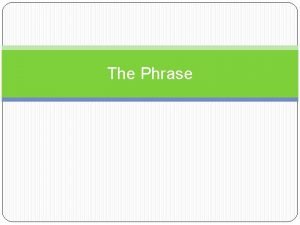Strategic management and Strategy The phrase strategic management







- Slides: 7

Strategic management and Strategy • The phrase "strategic management" is sometimes used as a synonym for "strategy, " but the two terms are not actually the same. A company's strategy is its plan for victory in competition with other companies. Strategic management is a process formulating and implementing a strategy. • Strategy is a set of key decisions made to meet objectives. • A strategy of a business organization is a comprehensive master plan stating how the organization will achieve its mission and objectives.

. • A corporate level strategy involves all the strategic decisions that are made by a company that affects the whole organization or company. Most organizations will only use this one strategic plan in all their operations • In a company where separate parts operate as viable entities, strategic corporate planning is a group exercise. Each part has its own procedures, process and plan. In such situations, the performance of the corporate planning plays a big role in the planning of each part or division. Companies with many divisions rely on corporate level strategy to allocate staffing, capital and other resources. Typically, corporate strategy is effective in making plans that affect all of the operations and processes of a company.

Tall Organizational • Tall Organizational Structure • Large, complex organizations often require a taller hierarchy. In its simplest form, a tall structure results in one long chain of command similar to the military. As an organization grows, the number of management levels increases and the structure grows taller. In a tall structure, managers form many ranks and each has a small area of control. Although tall structures have more management levels than flat structures, there is no definitive number that draws a line between the two.

Flat Organizational • Flat Organizational Structure • Flat structures have fewer management levels, with each level controlling a broad area or group. Flat organizations focus on empowering employees rather than adhering to the chain of command. By encouraging autonomy and selfdirection, flat structures attempt to tap into employees’ creative talents and to solve problems by collaboration.

vertical organizational • In a vertical organizational structure, employees have a clear path to move up the ladder if they want to earn more money and assume more responsibility. There is less confusion in a vertical organizational structure because employees receive their policy directions and day-to-day assignments from their direct manager, who interprets orders from the top, and employees send information about their work as well as their ideas up the hierarchical structure, reporting first to their direct manager. A major disadvantage of a vertical organizational structure however is that it doesn't encourage people to collaborate and share information across the reporting structure. People are more likely to develop into cliques, which in turn compete for power. This could also result to lack of innovative ideas because employees do not have the flexibility they need to share their ideas with you and with others in the company.

Tall Structure Pros And Cons • The pros of tall structures lie in clarity and managerial control. The narrow span of control allows for close supervision of employees. Tall structures provide a clear, distinct layers with obvious lines of responsibility and control and a clear promotion structure. Challenges begin when a structure gets too tall. Communication begins to take too long to travel through all the levels. These communication problems hamper decision-making and hinder progress.

Flat Structure Pros And Cons • Flat organizations offer more opportunities for employees to excel while promoting the larger business vision. That is, there are more people at the “top” of each level. For flat structures to work, leaders must share research and information instead of hoarding it. If they can manage to be open, tolerant and even vulnerable, leaders excel in this environment. Flatter structures are flexible and better able to adapt to changes. Faster communication makes for quicker decisions, but managers may end up with a heavier workload. Instead of the military style of tall structures, flat organizations lean toward a more democratic style. The heavy managerial workload and large number of employees reporting to each boss sometimes results in confusion over roles. Bosses must be team leaders who generate ideas and help others make decisions. When too many people report to a single manager, his job becomes impossible. Employees often worry that others manipulate the system behind their backs by reporting to the boss; in a flat organization, that means more employees distrusting higher levels of authority













